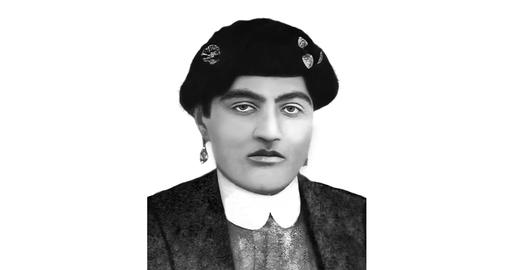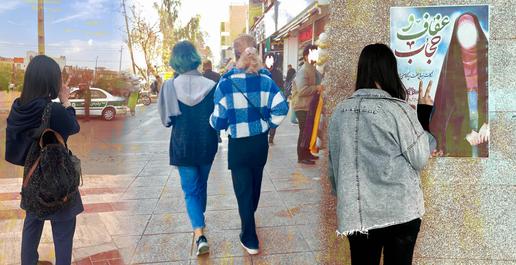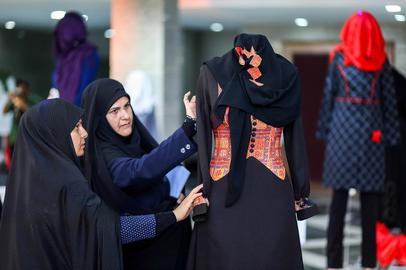Mohtaram Eskandari could not walk upright because, as a child, she suffered from a spinal cord injury. However, she never bowed to patriarchy and never yielded to the laws that the men of her family, the royal family, had imposed on women.
Mohtaram Eskandari was born in 1895. His father, Prince Mohammad Ali Mirza Eskandari, was a descendant of the early 19th-century Qajar King Fath-Ali Shah. He was an intellectual, a constitutionalist and a founder of Society of Humanity, a pseudo-Masonic group in Iran that was active from 1904 to 1908. The society was inspired by the philosophies of Saint Simon and Auguste Comte. Mohammad Ali Mirza also taught at Dar ul-Funun (Polytechnic College), the first Western-style institute of higher education in Iran that was founded in 1851.
Respect for the rights of individuals, especially women, was a central principle of the Society of Humanity. Mohammad Ali Mirza came to believe that, to achieve real progress, Iran needed literate women. He encouraged Mohtaram to learn and he became his first teacher.
Later, His father hired Mirza Mohammad Ali Khan Mohaqqeqi, a young teacher at Dar ul-Funun who had been educated in the West, to teach her literature, history and French language. Eventually, the two married and, in her new home, she came to know other women who, like her, wanted to achieve equal rights for women.
Since she turned 10, Mohtaram had been a witness to the role played by Iranian women in the Constitutional Revolution that started in 1905.
After Mohammad Ali Shah Qajar was deposed by pro-Constitution forces in 1909, the 2nd Iranian parliament invited the American William Morgan Shuster in 1911 to come to Iran to manage the country’s finances. The Russian government opposed the actions taken by Shuster, sent its army to the Iranian Caspian Sea port of Bandar Anzali and threatened that if Shuster was not expelled the Russian army would march to Tehran.
After years of fighting for their democratic rights, Iranians of every walk of life were enraged by the Russian ultimatum, a flagrant attempt to interfere in the internal affairs of the country. Many rose in protest, including thousands of women in Tehran who, wearing a burial shroud under their chadors, went to the parliament and told deputies that if they could not stand up to Russia they should let women run the country’s affairs and deal with the Russians.
The very young Mohtaram was among these women. She also came out in support of establishing Bank Melli, the National Bank, and of consuming domestic products instead of those exported to Iran by imperial powers.
Society of Patriotic Women
After reaching adulthood, Mohtaram Eskandari worked as a teacher and served as assistant principal of a girls’ government school. Unhappy with the progress of women’s rights, she established the Society of Patriotic Women which above all aimed to promote women’s right to education. The society held regular meetings at the homes of Mohtaram, Mastoureh Afshar and Noor-ol-Hoda Mangeneh, two other feminist pioneers. They also published a magazine called Patriotic Women which published their views about subjects such as women’s rights and education, the dangers of child marriage, ending laws that require women to cover their heads and the promotion of domestic products.
These women activists successfully launched several girls’ schools in Tehran throughout the 1920s, but they did not stop there. They wanted to create schools for adult women who had never had a chance to study — the majority of Iranian women at the time.
They believed that the progress of Iranian society depended on equal education for women. The society petitioned the parliament to take action to promote women’s education and to develop domestic industries. The founding of hospitals for poor women was also among the goals of the Society of Patriotic Women.
Despite her unhappy physical condition, Mohtaram Eskandari worked hard as the first director of this society and delivered fiery speeches in support of women’s education and against mandatory hijab. She was one of the first Iranian women to remove her headscarf.
The First Women’s Theater Performance
To achieve any of the ambitious goals of the society, the organization needed capital. In the spring of 1919, with the cooperation of Mirzadeh Eshghi, a patriotic Iranian writer, poet and playwright, the society staged a play by the name of Adam and Eve in Tehran’s Atabak Park, where the Russian embassy is currently located. The theme of the play was women’s freedom. According to historical sources, more than 4,000 women, including a number of Europeans, attended the performance. The performance brought 400 tomans to the society, but religious zealots and Tehran’s clergymen managed to prevent the play from being performed again. In any case, the society used the money to pay for classes for adult women.
This was the first theatrical performance by women in Iranian history, so they decided to turn the tradition on its head: Instead of boys playing women, women would play men.
In early 1924, the Society of Patriotic Women learned that boy peddlers were selling a pamphlet named The Wickedness of Women in Toopkhaneh Square, Tehran’s main square. It was written by opponents to women's education and freedom. Members of the society decided to do something about it.
Mohtaram Eskandari, along with seven other women, went to Toopkhaneh Square to remove the copies of the pamphlet from the hands of the children and set them on fire in the middle of the square, at the same exact place where the constitutionalists were once hanged by Mohammad Ali Shah Qajar.
After burning the pamphlets, the women were arrested by police. “We burned the books to show our action in defending the honor and uprightness of your mothers and sisters. We have wisdom like all human beings, and we are not wicked,” Mohtaram Eskandari later told the court.
The arrested women were released, and Mohtaram Eskandari's name was recorded as the first woman who was arrested in contemporary history for rebellion in Iran.
Shortly after her arrest, doctors said surgery should be performed on Mohtaram’s vertebral column, which had been damaged in a childhood accident. Her back was always bent and she was frequently made fun of as the “hunchback.”
Before going into the surgery, she called on the Society of Patriotic Women not to stop working for women and their rights, even for a short moment.
Mohtaram Eskandari did not survive the surgery and died in July 1924 at the age of 29.
After her death, Sediqeh Dowlatabadi, another pioneer of women’s rights, wrote: “The recent loss of Mohtaram Eskandari has depressed me so much that I cannot explain it, because I know the great efforts of this brave Iranian girl and I conceive her loss as a great misfortune. Yes, her sacrifices were admirable. I will never forget that they repeatedly condemned her at the conferences. But she listened to everything and tried not to get herself distraught or upset. With steady steps and determination, she continued her goals. In my life, she was the first Iranian woman I have seen who never got tired of doing all she could to reach the goal she had in mind. I just hope that all the sisters of my homeland do not let the work of this respectable woman go away and that the foundation she had established will not break.”

























comments